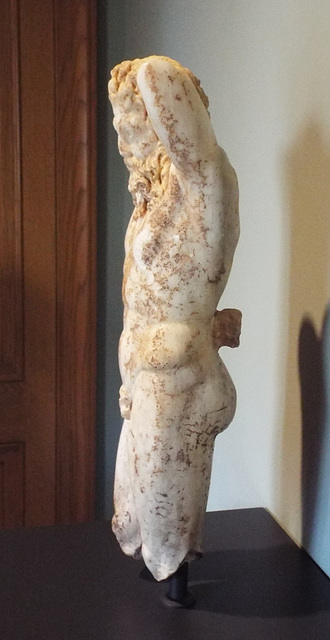See also...
Keywords
Authorizations, license
-
Visible by: Everyone -
All rights reserved
-
113 visits
Marsyas Table Leg in the Getty Villa, June 2016


Title: Furniture Support Shaped as a Hanging Marsyas
Artist/Maker: Unknown
Date: A.D. 100–200
Medium: Marble with polychromy
Dimensions: 46.4 × 15.9 × 9.5 cm (18 1/4 × 6 1/4 × 3 3/4 in.)
Place: Roman Empire (Place Created)
Culture: Roman
Object Number: 72.AA.107
Alternate Titles: Marsyas (Alternate Title)
Department: Antiquities
Classification: Sculpture
Object Type: Mythological figure
In Greek mythology, the satyr Marsyas, a creature part horse, part human, challenged Apollo, the god of music, to a flute contest. Apollo won and punished Marsyas by having him hung from a tree and skinned alive. For the Romans, the story of Marsyas served as an example of the consequences of hubris, or excessive pride, and of foolishly challenging one's betters. Yet even with this harsh message, figures of Marsyas were popular in the eastern part of the Roman Empire, and they were frequently used as table supports.
This broken Marsyas comes from just such a table. Traces remain of the paint and gilding that originally elaborated the figure. As is often the case with these table supports, the unknown Roman sculptor has changed the emphasis from a hanging figure to a standing one. The sculptor also appears to have confused or conflated his mythology. The two small horns emerging from the forehead of the figure are not appropriate for Marsyas; they are characteristic of another partially human Greek creature, the god Pan. The sculptor has combined traits of Marsyas and Pan into one figure.
Text from: www.getty.edu/art/collection/object/103SW9
Artist/Maker: Unknown
Date: A.D. 100–200
Medium: Marble with polychromy
Dimensions: 46.4 × 15.9 × 9.5 cm (18 1/4 × 6 1/4 × 3 3/4 in.)
Place: Roman Empire (Place Created)
Culture: Roman
Object Number: 72.AA.107
Alternate Titles: Marsyas (Alternate Title)
Department: Antiquities
Classification: Sculpture
Object Type: Mythological figure
In Greek mythology, the satyr Marsyas, a creature part horse, part human, challenged Apollo, the god of music, to a flute contest. Apollo won and punished Marsyas by having him hung from a tree and skinned alive. For the Romans, the story of Marsyas served as an example of the consequences of hubris, or excessive pride, and of foolishly challenging one's betters. Yet even with this harsh message, figures of Marsyas were popular in the eastern part of the Roman Empire, and they were frequently used as table supports.
This broken Marsyas comes from just such a table. Traces remain of the paint and gilding that originally elaborated the figure. As is often the case with these table supports, the unknown Roman sculptor has changed the emphasis from a hanging figure to a standing one. The sculptor also appears to have confused or conflated his mythology. The two small horns emerging from the forehead of the figure are not appropriate for Marsyas; they are characteristic of another partially human Greek creature, the god Pan. The sculptor has combined traits of Marsyas and Pan into one figure.
Text from: www.getty.edu/art/collection/object/103SW9
- Keyboard shortcuts:
Jump to top
RSS feed- Latest comments - Subscribe to the comment feeds of this photo
- ipernity © 2007-2025
- Help & Contact
|
Club news
|
About ipernity
|
History |
ipernity Club & Prices |
Guide of good conduct
Donate | Group guidelines | Privacy policy | Terms of use | Statutes | In memoria -
Facebook
Twitter











Sign-in to write a comment.